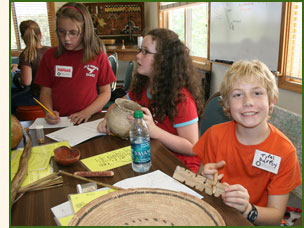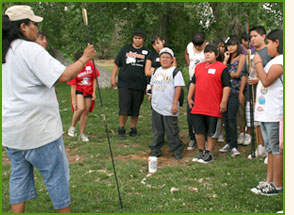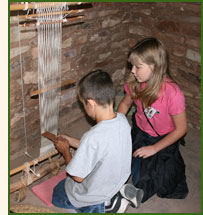|
Pueblo Indian History for Kids teaches students about a part of history that is overlooked in too many textbooks: the thousands of years that indigenous peoples thrived in North America before Europeans even knew that the continent existed. American history did not begin in 1492. It began at least 15,000 years ago, when Ice Age hunter-gatherers first crossed the Bering land bridge from Siberia. That is where, and when, our chronology begins. It continues to the present, with a glimpse into the lives of the Pueblo Indian farmers who still live in the American Southwest today. Why Teach Pueblo Indian History? First, the story of how Pueblo culture developed from such ancient roots is an amazing chronicle of human adaptation, ingenuity, and resilience. The transition from hunting and gathering to farming is an age-old story that has been repeated at various times around the globe, with profound effects that continue to shape our world today. To learn how one such culture experienced its "agricultural revolution" is to better understand the agrarian roots from which most modern societies developed.  Second, because the descendants of the ancestral Pueblo people still live in dozens of traditional communities in the Southwest today, the study of Pueblo culture encourages children to view history not as a series of isolated events in the past but, rather, as a dynamic, living continuum that plays out every day, with real-life consequences. When students learn how Pueblo children in the nineteenth and twentieth centuries were taken from their parents and forced to attend boarding school, they can both empathize with their counterparts and begin to understand how, even generations later, those events continue to affect relationships between native peoples and governments.  Finally, we have chosen to focus on Pueblo Indians because that's what we do at Crow Canyon! For almost 30 years, our archaeologists have conducted research into the ancestral Pueblo people of the Mesa Verde region, and our education staff has developed creative ways to teach that history to the thousands of students and adults who have attended our on-campus programs. In addition, Crow Canyon has developed important relationships with Pueblo Indian individuals and communities to ensure that their voices and perspectives are reflected in our research, education programs, and publications. Using the ChronologyPueblo Indian History for Kids is designed for online use. It is geared primarily to upper elementary and middle school grades, although it may be adapted for use with younger students, if adequate guidance is provided. Every class is different, and you know yours best! (High school students and adults: See Peoples of the Mesa Verde Region, which is a more detailed and comprehensive chronology.) We strongly recommend that students start at the beginning and move through the timeline in order! The opening page contains important information about the Mesa Verde region, the local environment, and archaeology that sets the stage and helps students understand what follows. Once they enter the timeline, students may move between time periods by clicking on the colorful buttons arrayed across the top of the banner. Students can return to the opening page at any time by clicking on the red "Home" button in the banner. Throughout, vocabulary words that may be unfamiliar to your students are highlighted in bright turquoise. Clicking on a highlighted word will take students to a definition, sometimes accompanied by an illustration (the individual definitions appear in pop-up windows, so the students' computers must be set to allow pop-ups). The entire glossary may be accessed by clicking on the "Glossary" button in the banner. IllustrationsWe have incorporated many different kinds of illustrations in Pueblo Indian History for Kids: colorful maps, line drawings, reconstructions, and photographs. Please be aware that many individuals and institutions created and/or provided these illustrations; credits are provided in the illustration credits, which may be accessed through a link at the bottom of each main page. If you would like to borrow an illustration for any purpose, please e-mail the managing editor. We will be happy to assist you with your request—and ensure that the rights of the copyright owner are respected! For additional information on borrowing, please see To Borrow, Cite, or Request Permission. Teacher SurveyPlease take our survey! Crow Canyon is committed to providing relevant, high-quality educational content to teachers and students. Future editions of Pueblo Indian History for Kids will reflect not only new archaeological discoveries but the needs and suggestions of teachers as expressed in survey responses. We want to hear from you! |
 DONATE TODAY
DONATE TODAY


